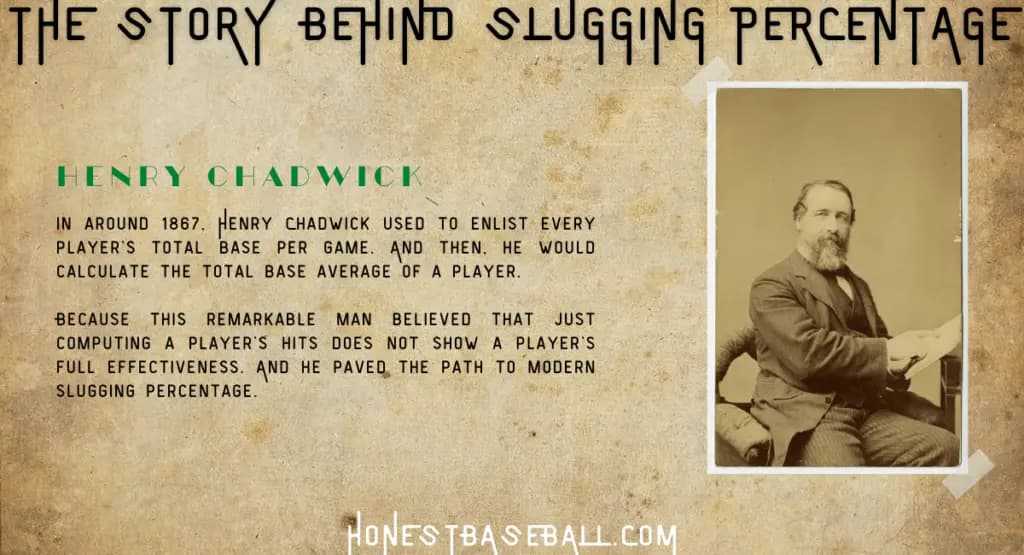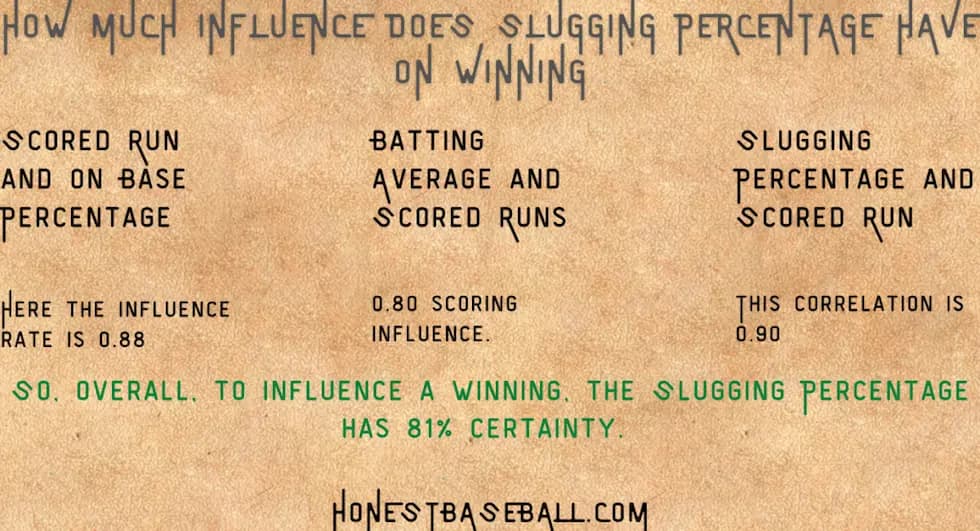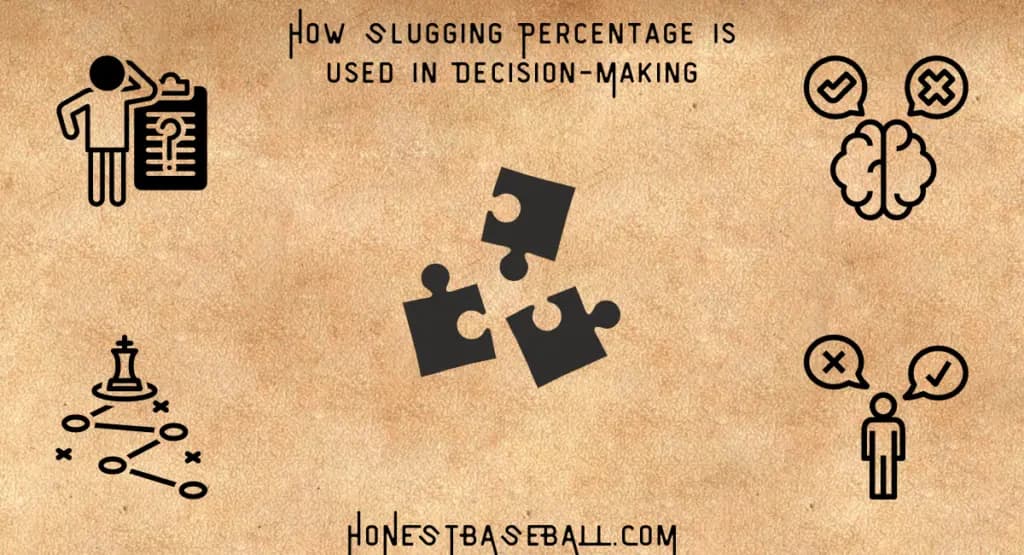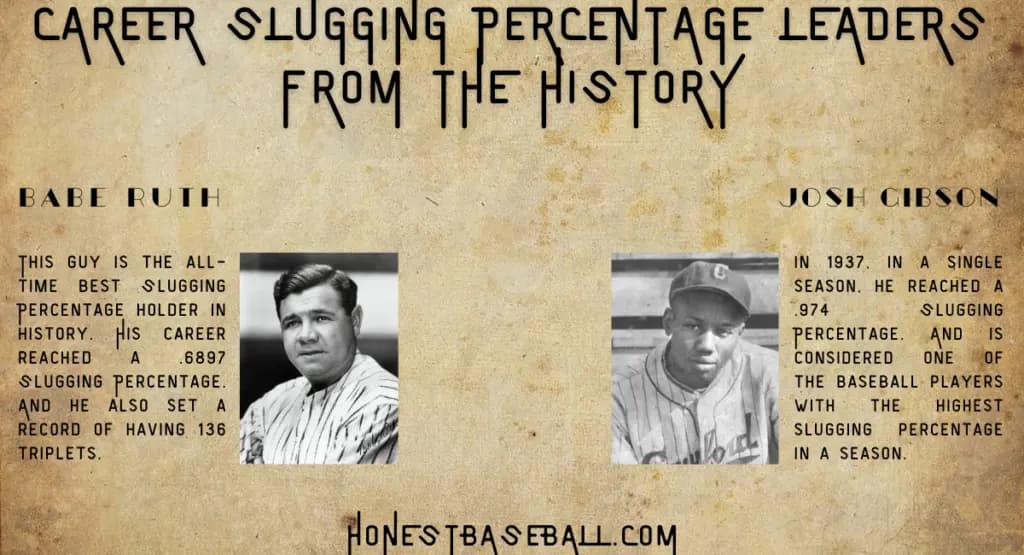Last Updated on July 5, 2023
Most people do not understand the Slugging Percentage as it is a complex mathematical term. So anyone can get confused. In baseball statistics, the Slugging Percentage is a measure of the batting productivity of a hitter. Comparatively, slugging percentage represents the total number of bases a player records per at-bat. Though in this article, I will teach you What is Slugging Percentage step by step in the easiest way possible.
This Slugging Percentage statistic of a player is a significant number to know about. As many decisions depend on it. When preparing my team for a competitive game, I always prioritize getting other team players’ Slugging Percentages and other necessary stats. This helps me to set my team’s combination. And aids in many additional researchers. All to win the game.
Nowadays, games are getting more complicated. The use of complex statistics is increasing. A coach and other team executives are very much dependable on this math. These mathematical formulas help us to assume the future. Understanding the layout, we should apply. Basically, Slugging Percentage and other stats help us to build strategies more efficiently and effectively.
So, without further ado, let’s dive in.
What is a Slugging Percentage in Baseball
A player’s Slugging Percentage is a stat that indicates his “Base Advancing Rate.” How skilled one player is in advancing Base at each bat. This is a statistic in baseball that represents the average number of bases a player reaches per at-bat. It is considered slightly superior to the batting average since it is weighted according to the number of bases reached.
In simple terms, this Slugging Percentage shows, on every hit, your chance of advancing to the following Base (Batting Performance indicator).
Do you know what a grand slam is? If you do not, then read the following article || What is A Grand Slam
Is Slugging Percentage Really a Percentage
The term Slugging Percentage appears incongruous with its actual meanings. The statistical information is the average base totals a pitcher has at each at-bat, not true percentage statistics.
And usually, it comes in without the decimal point. So if you saw a Slugging Percentage of a player is: 456, it means .456.
The Story Behind Slugging Percentage

From the history of Baseball, the Slugging Percentage is a comparatively new statistic. And have been in use for a long time. While batting average counts a home run the same as a single, slugging percentage takes into account the actual number of bases scored.
In around 1867, Henry Chadwick used to enlist every player’s total base per game. And then, he would calculate the total base average of a player. Because this remarkable man believed that just computing a player’s hits does not show a player’s full effectiveness. And he paved the path to modern slugging percentage.
In modern times, the Slugging Percentage is calculated using total bases per at bat. Later, in 1981, the Slugging Percentage got regular game usage.
Learn about the history of Baseball || How Baseball Came Alive
The Formula to Calculate Slugging Percentage

As I said before, the Slugging Percentage is not actually a percentage, it basically shows the average base score.
The formula of Slugging Percentage = (Total Bases ÷ At Bats)
Total Bases = Singles + (2 × Double) + (3 × Triples) + (4 × Home Runs)
Stage 1.
See, if you want to calculate your Slugging Percentage, you need to know the total number of bases you get from the hits. Do not enlist other base advancements.
Stage 2.
As most players’ stats do not enlist singles. So, first, you need to calculate how many singles you got. And to get that rule is easy.
First, sum up all your doubles, triples, and Home Runs/ And then subtract it from the total hits you have. Then you will get all the singles.
For example,
Imagine you have scored 100 Home Runs, 76 Triples, and 86 Doubles. Your total hits are 400.
So,
400 – (100+ 76+ 86)
= 400 – 262
= 138
Therefore, you have 138 singles.
Stage 3.
Now you must know the total number of bases.
And the Formula is to calculate total bases,
Total Bases = Singles + (2 × Double) + (3 × Triples) + (4 × Home Runs)
For example,
Total Bases = Singles + (2 × Double) + (3 × Triples) + (4 × Home Runs)
= 138 + (2 × 86) + (3 × 76) + (4 × 100)
= 938
Hence, your total base score is 938.
Stage 4.
Now you have to divide the total bases achieved by the total number of at-bats to get your Slugging Percentage.
For Example,
Slugging Percentage = (Total Bases ÷ At Bats)
= (938 ÷ 1573)
= .5963
Finally, you got your Slugging Percentage which is .5963.
Extra Easy Way for Slugging Percentage Calculation,
Well, there is another easiest way to calculate Slugging Percentage.
The Formula is,
Hits + Double + (2 × Triples) + (3 × Home Runs)
To calculate total bases, you take a batter’s total number of hits and add one additional base for each double, two for each triple, and three for each homer.
Example Calculation,
Hits + Double + (2 × Triples) + (3 × Home Runs)
= 400 + 86 + ( 2 × 76) + (3 × 100)
= 938
Then you Divide total bases by the number of at-bats to get the slugging percentage,
Slugging Percentage = (Total Bases ÷ At Bats)
= (938 ÷ 1573)
= .5963
Why does Slugging Percentage in Baseball Matters
Every hitter has a different energy level. And that creates their demand in the team in different ways. As a Slugging Percentage shows their potential to produce that energy.
How much capability does a player hold to hit a ball and run to the next base? This answer you will find in the Slugging Percentage. So this is a valuable measurement of a hitter.
With the Slugging Percentage, a coach can Assume the gameplay and set the offense strategies.
DO you agree Baseball is a boring game ? Let’s Find out the reasons behind the boredom || Why is Baseball So Boring
What is a Good Slugging Percentage in Baseball
As Slugging Percentages indicate the players’ performance, these stats are categorized into different levels. And those levels are basically known as below average, average, intermediate, and outstanding (Just an average follower thinks this way to make it easy).
And these also vary based on league to league, season to season, and in different rules changes.
Generally, a .350 is taken as a poor Slugging Percentage. A .450 slugging point, on the other hand, is an average. On the next level, a .550 Slugging Percentage makes you an excellent hitter. Finally, a .650 Slugging Percentage declares a player as an elite hitter.
How much Influence does Slugging Percentage have on Winning

For this part, you must have a basic understanding of correlation. And this way, you will know how a simple statistic can affect a game.
Here, we gathered data from every team from 1995 and made three types of correlations. In short, the percentage is combined with on-base percentage, to create another complicated formula.
Scored Run and On Base Percentage
- Here the influence rate is 0.88
Batting Average and Scored Runs
- 0.80 scoring influence.
Slugging Percentage and Scored Run
- This correlation is 0.90
So, overall, to influence a winning, the Slugging Percentage has 81% certainty.
Overall, this shows players’ efficiency and the chance of winning. Additionally, taking the assumption of the entire run. Additionally, the coach can rely on the statistics to take necessary strategies for the team.
How Slugging Percentage is used in Decision-Making

This Slugging Percentage statistic is often used to help the coach or the team’s executives reach a decision.
Coaches set the batting lineup using Slugging Percentage. As a coach, you may set the highest Slugging Percentage, holding the player in the position where you think the most significant threat is.
Slugging Percentage is also used in the team’s in-depth analysis.
A coach needs to calculate OPS to analyze a player’s productivity and his rate of reaching base. And you will need Slugging Percentage to do that.
More or less, if you need to run an analysis, the Slugging Percentage is taken as a core function. And it is more valuable than Batting Average.
Career Slugging Percentage Leaders from the History

You may wonder what the perfect Slugging Percentage is. If you can hit Home Run on every swing, you will have a perfect 4.000 Slugging Percentage. And if you can have one base run per hit, you will have a 1.000 Slugging Percentage.
Now, no player ever had a perfect 4.000 or 1.000 Slugging Percentage. However, they reached closer to 1.000.
Such players are,
Babe Ruth
- This guy is the all-time best Slugging Percentage holder in history. His career reached a .6897 Slugging Percentage. And he also set a record of having 136 triplets.
Josh Gibson
- In 1937, in a single season, he reached a .974 Slugging Percentage. And is considered one of the baseball players with the highest slugging percentage in a season.
There are players like – Ted Williams, whose career Slugging Percentage is .6338. Lou Gehrig, on the other hand, has a .6324 Slugging Percentage. Finally, we can name Mule Suttles, who reached a .877 Slugging Percentage in a Single season in 1926.
Learn about the best team records in history || Top 10 Best MLB Team Records of the History
Frequently Asked Questions
1. What is a Good Slugging Percentage?
ANSWER: For Major League Baseball (MLB) or American League, over .400 to .450 Slugging Percentage is taken as good. Then over .500 to .550 is outstanding. Nonetheless, if you can have over .650 career Slugging Percentages, then you will be an elite hitter.
2. Why are walks not calculated into Slugging Percentage?
ANSWER: Slugging Percentage shows a hitter’s power productivity. In simple terms, when he hits a ball, what is the chance of a base score? So, if you include walks into this, you will not have the correct answer. That is why you are not calculating Slugging Percentage using walks or hits by Pitches.
3. How do you calculate Slugging?
ANSWER: Well, The slugging percentage formula is rather simple, as it’s calculated by dividing the total number of bases by the total number of at-bats.
The formula of Slugging Percentage = (Total Bases ÷ At Bats)
Total Bases = Singles + (2 × Double) + (3 × Triples) + (4 × Home Runs)
4. Is a 1.000 Slugging Percentage Good?
ANSWER: See, if you have over .550 Slugging Percentage, then it will be taken as a good score. So, 1.000 is indeed a high Slugging Percentage for every league. This might not be readily apparent given that a Major League Baseball player’s Slugging Percentage is almost always less than 1.000 (total at-bats for the season).
5. What is the Perfect Slugging Percentage?
ANSWER: Imagine a situation, where on each hit, you are scoring a Home Run. Though it is kind of impossible to accomplish. But if you can, you will have a 4.000 Slugging Percentage, which is the perfect one.
The Final Words
Slugging Percentage is one of the essential stats among the other Baseball statistics. This is the base formula of other decision-making stats.
A game, of course, depends on the players’ ability and form. However, you can have a pre-assumption of the game through many stats.
And here, the Slugging Percentage and the correlation can help you to be more specific on every move only if you use it correctly.
For my students’ development, I do not just focus on their physical training. I always encourage them to study their opponents. I also train them to use their brain accordingly. But not just to hit the ball at the right time but also to understand their opponents.
On the other hand, as a coach, I need the Slugging Percentage of other teams and my team to make better strategies for the game.
However, I hope you get every answer related to What is Slugging Percentage. And if you have more queries, please feel free to ask in the comment box.
META DESCRIPTION
RELATED TOPICS
What Is a Grand Slam in Baseball? An Immersive Batting Skill
What Is Offense in Baseball? (Including Skills & Strategies)
What Is a Good ERA in Baseball? | Critical Facts Explained
What is a Pitcher in Baseball (Every Fact you Need to Know)

Hello everyone. My name is Jason Butler, and I live in California, America. I was a professional AAA Minor League Baseball player. I lost my chance of playing MLB for injury issues, but I did not lose my love for baseball. I attended the coaching training program and am now working as a coach in a small school in San Diego.
I always love to share my experience and knowledge if that can help you. Play baseball, and stay fit.
